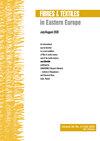用于评估防烟面罩材料能见度的系数
IF 0.9
4区 工程技术
Q3 MATERIALS SCIENCE, TEXTILES
引用次数: 0
摘要
摘要磷光在口罩材料改性中的应用是因为需要在使用相对较小面积的图形元素的同时显著提高其可见性。磷光染料吸收部分可见光谱,同时发射波长比吸收波长更长的辐射。因此,磷光物质可以发光,即使它在给定时间没有被照明(但在之前)。本文描述了基于反射系数、色度坐标以及从数字图像中测量的亮度等参数对两种型号的烟雾防护面罩的光学性能的研究,这两种面罩的内层具有过滤性能,外层具有印刷层。一种掩模类型的外表面印刷有磷光实心星形图案,而另一种掩膜类型的外表面具有磷光开放星形图案。内部过滤层的影响是根据外层的颜色和印刷类型来评估的。此外,还发现了磷光现象。这项研究的结果是开发出一种在特定使用条件下具有更好可视性的材料。本文章由计算机程序翻译,如有差异,请以英文原文为准。
Coefficients for Assessing the Visibility of Materials Used in Anti-Smog Face Masks
Abstract The application of phosphorescence for the modification of face mask materials is motivated by the need to appreciably increase their visibility while using graphical elements with a relatively small area. Phosphorescent dyes absorb part of the visible spectrum while emitting radiation at wavelengths that are longer than the absorbed ones. Thus, a phosphorescent substance can emit light even if it is not being illuminated at a given time (but was before). This paper describes studies of the optical properties based on parameters such as the reflectance coefficient, chromaticity coordinates, as well as luminance measured from digital images for two models of smog-protective face half-masks differing in terms of their inner layer with filtration properties and outer printed layer. The external surface of one mask type is printed with a phosphorescent solid star pattern, while the other with a phosphorescent open star pattern. The influence of the inner filter layer was assessed in correlation with the colour of the outer layer and the type of printing. Moreover, the phenomenon of phosphorescence was identified. The study resulted in developing a material with properties providing better visibility under defined use conditions.
求助全文
通过发布文献求助,成功后即可免费获取论文全文。
去求助
来源期刊

Fibres & Textiles in Eastern Europe
工程技术-材料科学:纺织
CiteScore
1.60
自引率
11.10%
发文量
12
审稿时长
13.5 months
期刊介绍:
FIBRES & TEXTILES in Eastern Europe is a peer reviewed bimonthly scientific journal devoted to current problems of fibre, textile and fibrous products’ science as well as general economic problems of textile industry worldwide. The content of the journal is available online as free open access.
FIBRES & TEXTILES in Eastern Europe constitutes a forum for the exchange of information and the establishment of mutual contact for cooperation between scientific centres, as well as between science and industry.
 求助内容:
求助内容: 应助结果提醒方式:
应助结果提醒方式:


